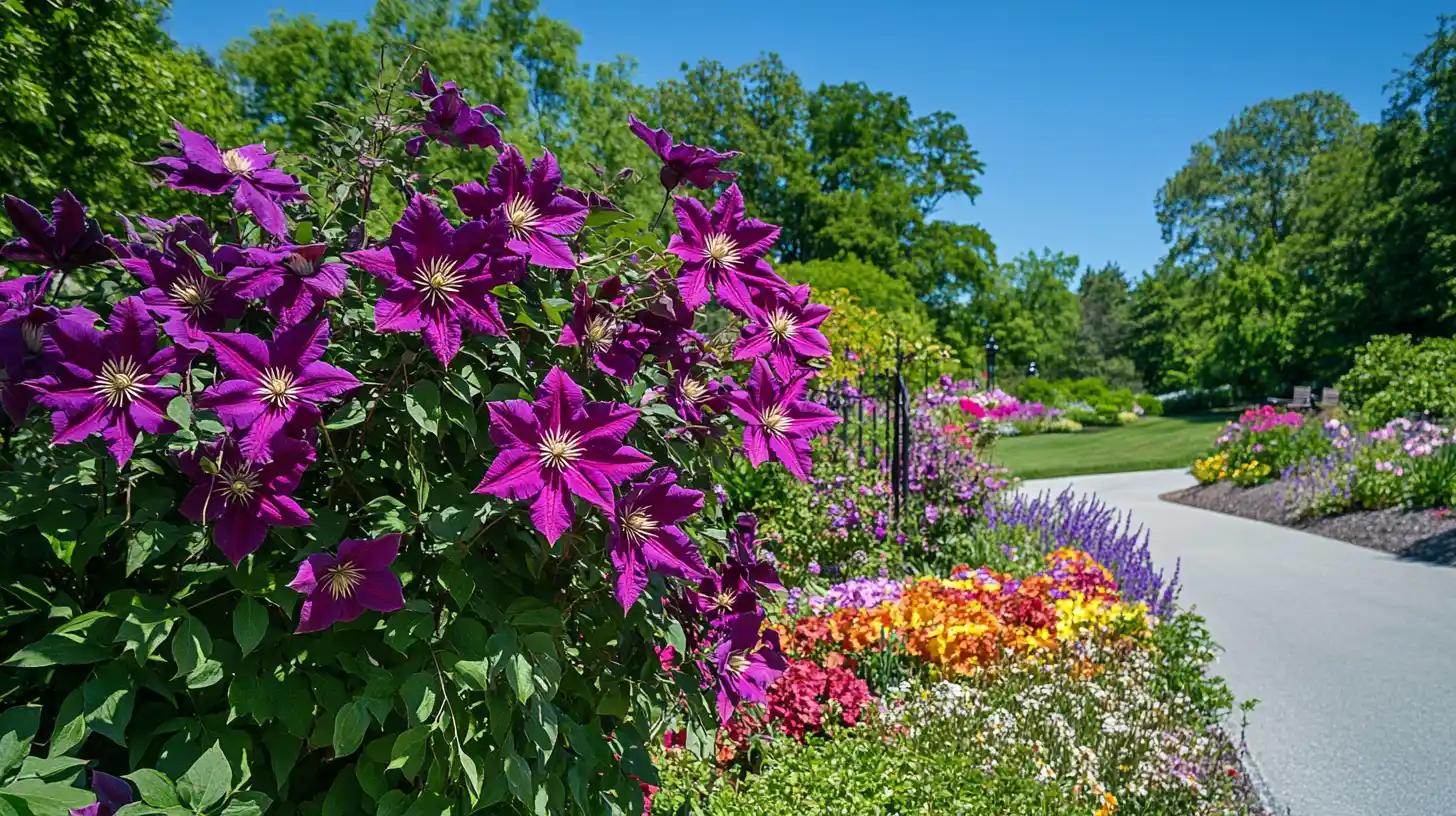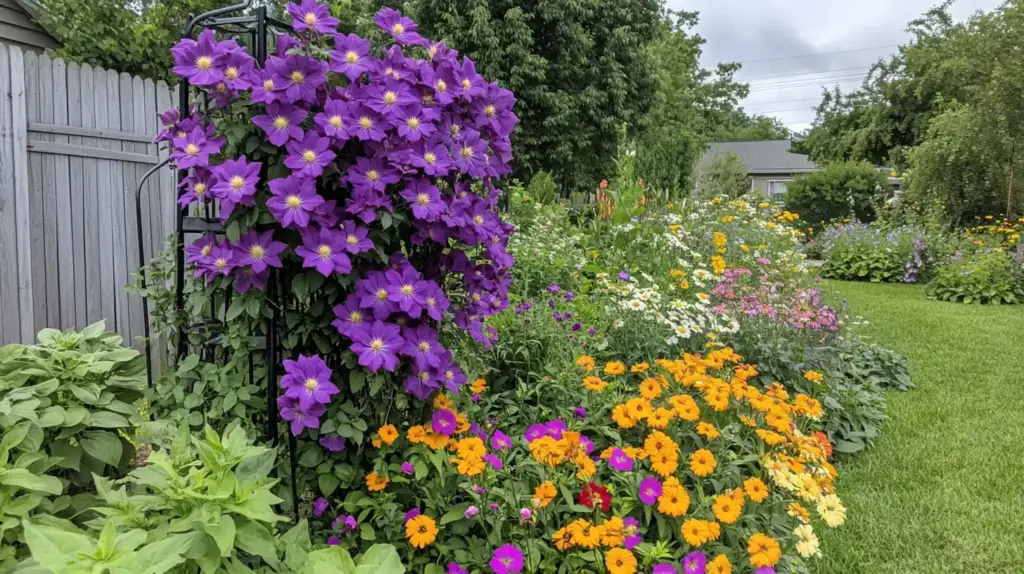If you’re dreaming of a garden that climbs with color and character, growing clematis vines could be the perfect solution. These perennial favorites add instant vertical charm and thrive with minimal effort. Whether you’re planting along a fence or showcasing blooms on a trellis, clematis are both eye-catching and versatile.
💡 Explore 10 Garden Trellis Ideas for Vertical Gardening to complement your clematis setup.
🌿 Love gardening inspiration? Follow me on Pinterest for bold plant ideas, tips, and seasonal color!
Table of Contents
Why Grow Clematis?
Important Considerations Before Buying Clematis
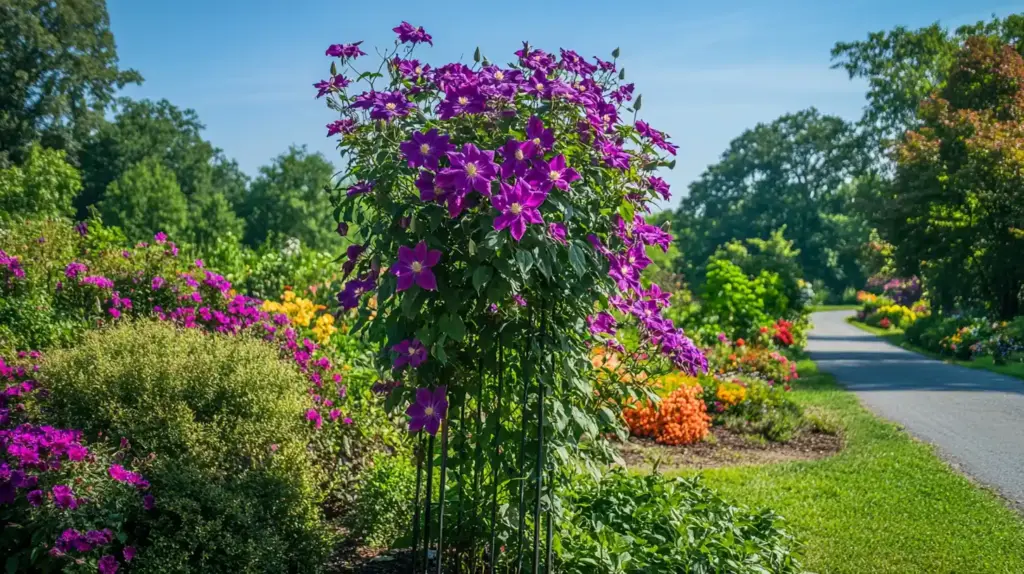
There are many reasons gardeners fall in love with growing clematis vines:
- They’re perennial plants, meaning they return year after year and get fuller with time.
- Their stunning vertical presence transforms simple trellises or arbors into showpieces.
- Clematis flowers come in a wide array of shapes and colors, from deep purples to soft pinks.
- They’re relatively easy to maintain, making them perfect for beginners.
Want a more curated approach to perennial gardening? Check out Perennials Made Easy for tips on creating beautiful, long-lasting flower beds.
Before you start planting, it’s essential to understand that not all clematis vines are the same. The success of growing clematis vines depends heavily on selecting the right type for your garden conditions and aesthetic goals.
Choose the Right Growth Habit
Clematis varieties fall into two primary categories: fast-growing vines and slower, more compact types. If you’re looking for rapid coverage on a trellis or fence, consider vigorous climbers like:
- Sweet Autumn Clematis – Known for its fragrant white blooms and rampant growth.
- Jackmanii – A classic purple-flowered variety that matures quickly.
- Warsaw Nike – Deep, velvety purple flowers and strong vertical growth.
If you prefer a more measured pace or plan to integrate clematis into a perennial border, slower growers or bush types may be better suited.
Sunlight Needs
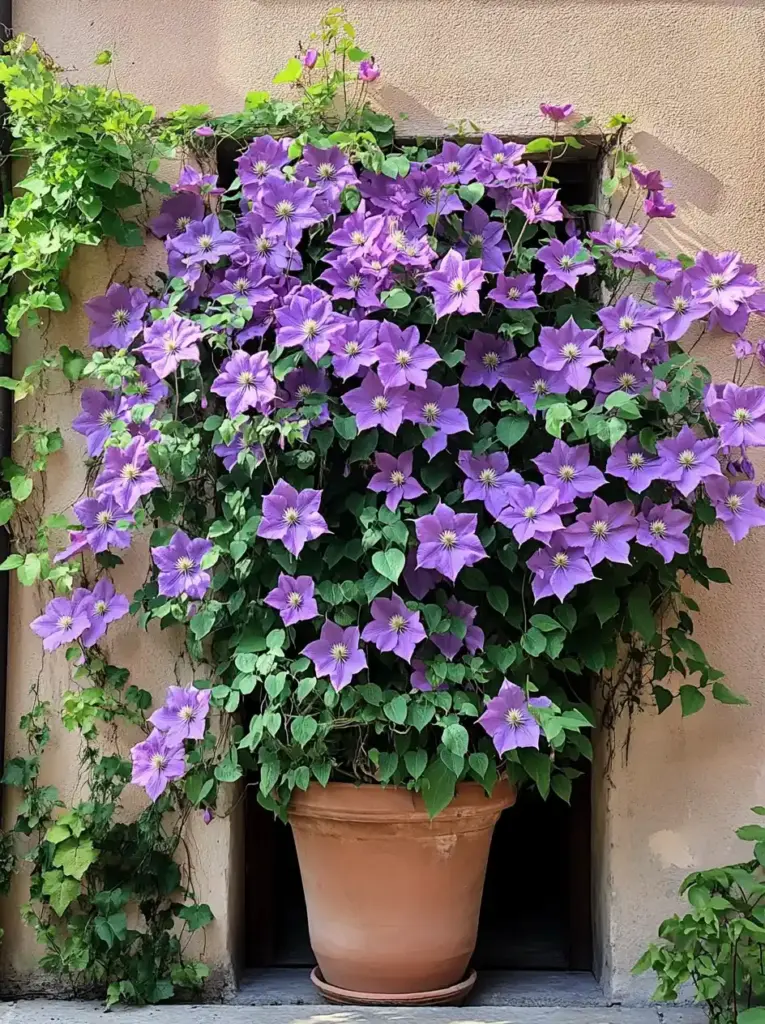
Most clematis vines thrive in full sun (6+ hours per day), but many tolerate partial sun (4–6 hours). That said, clematis follow an old gardening adage:
“Head in the sun, feet in the shade.”
To achieve this:
- Plant low-growing perennials or ground covers at the base to shade the roots.
- Add a layer of organic mulch to help regulate soil temperature and retain moisture.
Check for Pet Safety
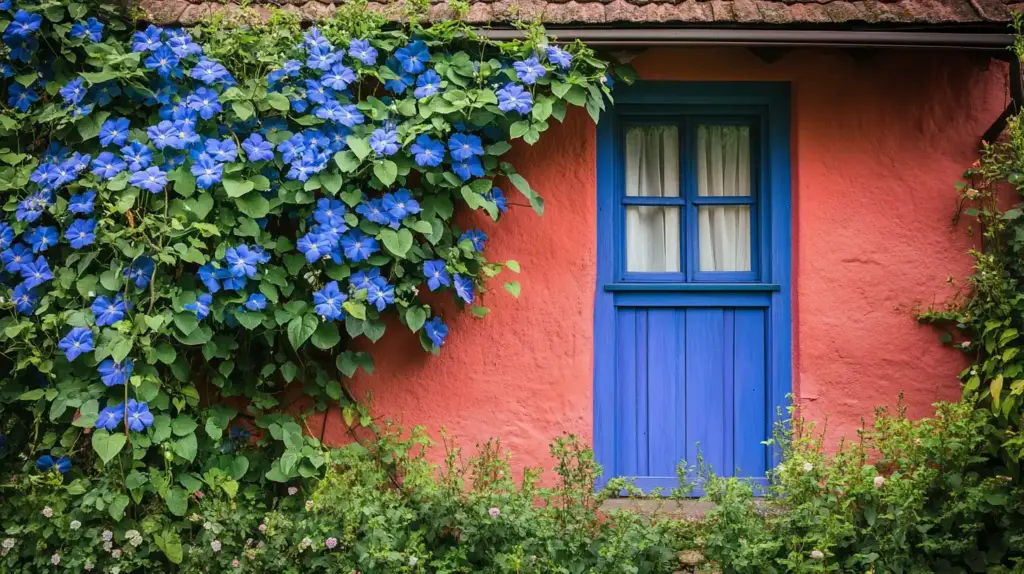
If you have dogs or cats, it’s crucial to research the specific clematis variety you’re considering. While not all types are toxic, some can be harmful if ingested. Always consult trusted plant toxicity databases or your vet.
Supporting Clematis Growth
Supporting clematis vines correctly is essential for both their health and visual impact. Before you even dig a hole, plan how your plant will climb and flourish.
Choose the Right Structure
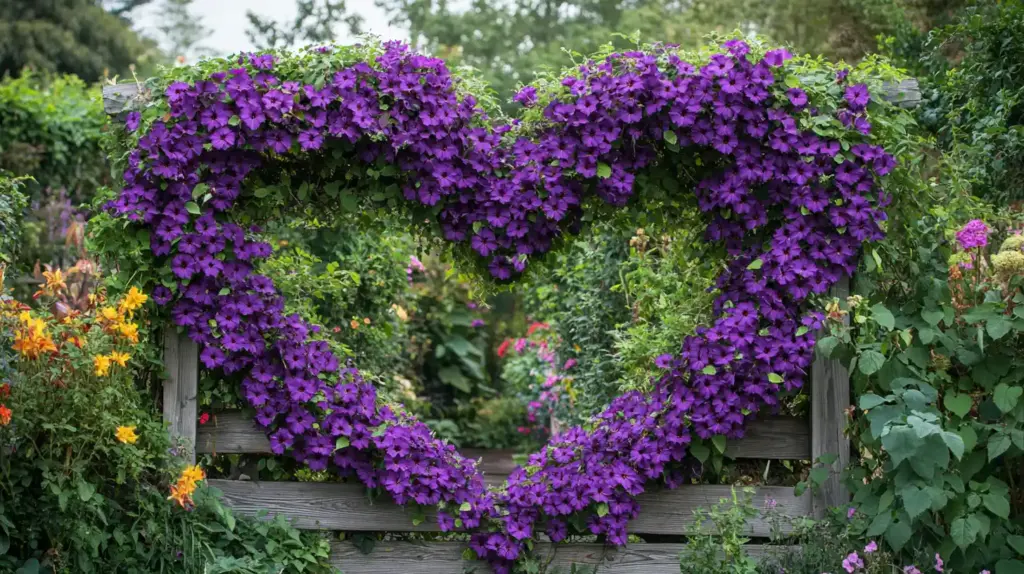
Clematis vines are natural climbers, but their climbing method varies by variety. Some produce twining leaf stems or tendrils that wrap easily around thin supports. Others are less self-sufficient and will need help getting started.
Popular structures for clematis support:
- Arbors and Trellises – Great for showcasing clematis as a focal point.
- Obelisks and Garden Towers – Ideal for vertical interest in flower beds.
- Fences and Railings – A practical and attractive way to cover plain barriers.
Pro Tip: Install your support before planting so you don’t disturb roots later.
Tie When Necessary
If your clematis isn’t a strong natural climber, loosely tie the vines to the support with soft garden twine or plant clips. Don’t tie too tightly—this can damage stems or restrict growth.
Use Shorter Types as Garden Fillers
Not all clematis are tall climbers. Some bush-type varieties stay compact and work well as fillers among other perennials. These types can spill beautifully over the edges of beds or mingle with companion plants.
Handle with Care
Clematis vines may look sturdy, but their stems are delicate and snap easily. If a vine breaks—don’t worry! It won’t harm the overall plant. Simply trim the damaged portion and let the rest keep growing.
How to Plant Clematis
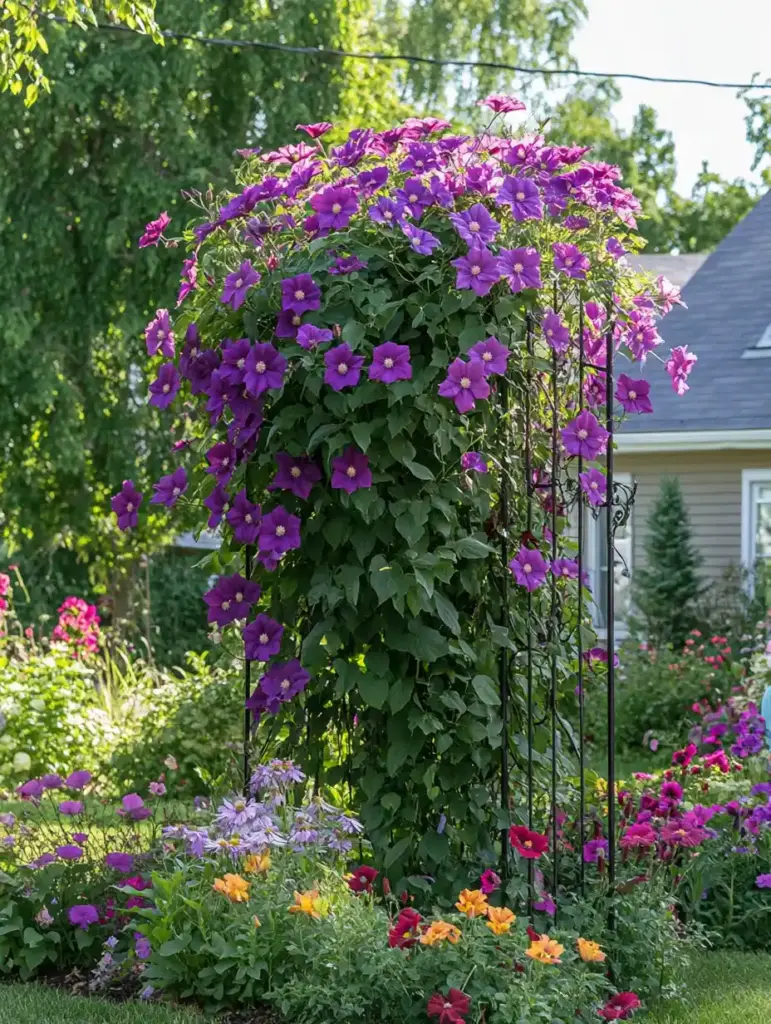
Proper planting makes all the difference when it comes to growing clematis vines successfully.
The best time to plant is in early morning on a cloudy day to reduce stress on the plant. Always check the label for sun exposure, size, and planting depth.
✅ Planting Steps:
- Dig a hole twice as wide as the nursery pot.
- Mix in rich compost or organic matter—especially helpful in sandy or clay-heavy soils.
- If soil is dry, fill the hole with water and let it soak in.
- Remove the plant gently—don’t pull from the top.
- Loosen the root ball to encourage outward growth.
- Place it in the hole at the same level as the soil in the pot, or slightly deeper (some gardeners prefer deeper planting to encourage more root growth).
- Backfill with amended soil, gently firming down.
- Water thoroughly.
For a no-fuss method, explore No-Dig Gardening Techniques that work beautifully with clematis and other perennials.
Step-by-Step Planting Guide

- Dig a Wide Hole
- Make the hole twice the width and slightly deeper than the nursery pot.
- This gives roots room to spread and improves soil aeration.
- Improve the Soil
- Mix in rich compost or well-aged organic matter to boost nutrients.
- If your soil is clay-heavy or sandy, this is especially important for drainage and fertility.
- Water the Hole First (If Dry)
- Pour water into the hole and let it soak in for 10–15 minutes if the soil feels dry.
- This ensures the surrounding soil is hydrated before planting.
- Gently Remove the Plant
- Squeeze the sides of the pot to loosen, then tip it upside down while supporting the plant from the base.
- Never yank it by the stem!
- Loosen the Root Ball
- Carefully tease the roots around the edges. This encourages them to spread out into the surrounding soil.
- Place the Plant at the Right Depth
- Plant at the same depth as in the nursery pot unless your variety recommends deep planting.
- Some gardeners advocate deeper planting to allow stem rooting, but others, including many experienced growers, stick with current soil level.
- Backfill and Firm Down
- Use the compost-soil mix to fill in the hole.
- Press gently to remove air pockets but don’t compact it too tightly.
- Water Thoroughly
- Give the plant a deep soak right after planting to help the soil settle and eliminate any remaining air pockets.
Structural Tips
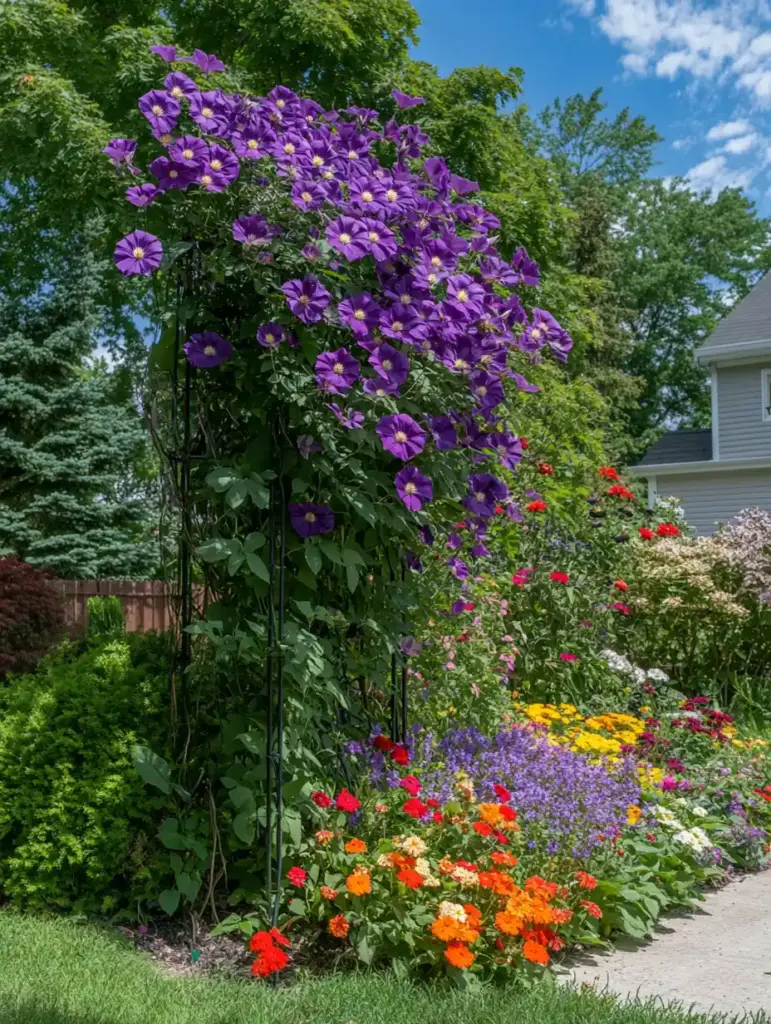
Even the healthiest clematis vine needs a little help to climb gracefully and avoid damage. These structural tips will help protect your plant and ensure a stunning vertical display.
Install Supports Before Planting
To avoid disturbing the roots later, always set up your climbing structure before planting. Whether you’re using a trellis, arbor, or obelisk, having it in place makes training the vines much easier and less stressful on the plant.
Be Gentle with the Vines
Clematis vines may look lush, but their stems are fragile and snap with little pressure. This is especially important when handling young plants.
- If a vine breaks, don’t panic. It won’t harm the overall health of the plant.
- Simply snip off the broken section and redirect growth from another shoot.
Train as They Grow
Once your clematis starts to grow, guide the vines toward their support by:
- Loosely tying new growth with soft twine or stretch tape
- Wrapping stems gently around the structure if the variety doesn’t self-cling
- Monitoring growth weekly to help direct coverage and reduce tangling
With these simple support strategies, your clematis will grow strong and provide spectacular blooms for years to come.
Frequently Asked Questions About Growing Clematis Vines
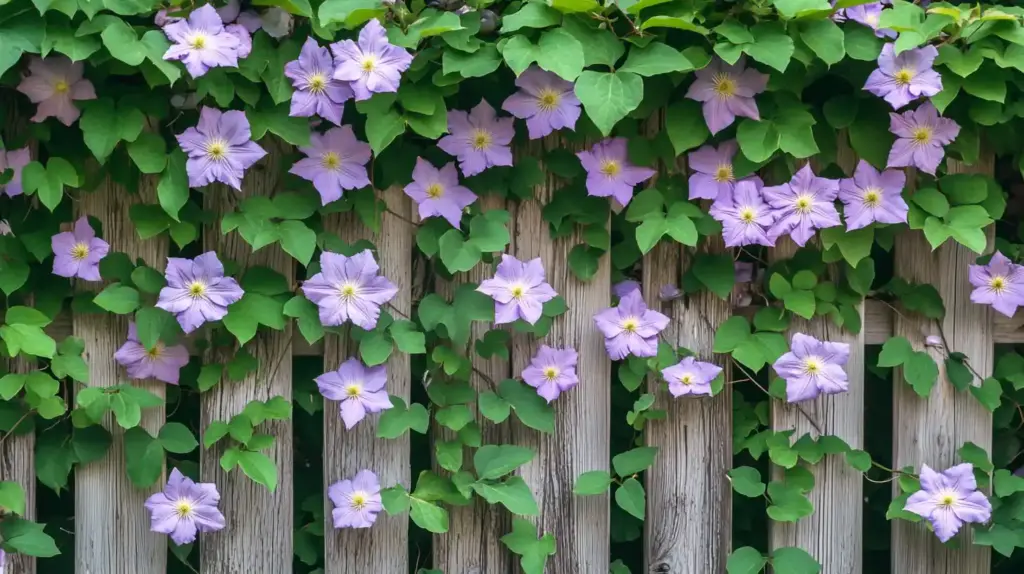
1. When is the best time to plant clematis vines?
The best time for growing clematis vines is in early spring or fall, during cool, overcast mornings. Planting at these times helps reduce transplant shock and gives the roots of your clematis vines time to establish before extreme weather sets in.
2. Do clematis vines need full sun?
Most clematis varieties thrive in full sun (6+ hours daily), making growing clematis vines in a bright spot ideal, but many also tolerate partial sun. Follow the classic rule for growing clematis vines: “Head in the sun, feet in the shade”—meaning the vines need sunlight, but the root zone should stay cool and shaded.
3. How fast do clematis vines grow?
Growth rate for growing clematis vines depends on the variety. Some, like Sweet Autumn Clematis or Jackmanii, are fast-growing clematis vines, while others take a few years to fully establish. Providing the right support and care for growing clematis vines will speed up the process.
4. How do I support clematis vines while they grow?
Install a trellis, arbor, or fence before planting to support growing clematis vines. Some growing clematis vines naturally cling with tendrils, while others need to be tied loosely with garden twine. Check the variety to know which method is best for growing clematis vines.
5. Can I grow clematis in containers?
Yes! Many compact varieties are perfect for growing clematis vines in large containers with proper drainage. Choose a deep container, use rich soil, and add a small trellis or cage for supporting your growing clematis vines. Water and fertilize regularly to keep your clematis vines thriving.
6. Why are my clematis vines not blooming?
Several factors may cause poor blooming:
- Too much shade
- Incorrect pruning (especially if pruning group is unknown)
- Lack of nutrients
- Plant is still establishing
Identify your clematis type and adjust care accordingly.
7. Are clematis vines toxic to pets?
Yes, some clematis varieties can be mildly toxic to dogs and cats if ingested, causing drooling, vomiting, or diarrhea. Always check plant safety if you have pets that explore your garden.
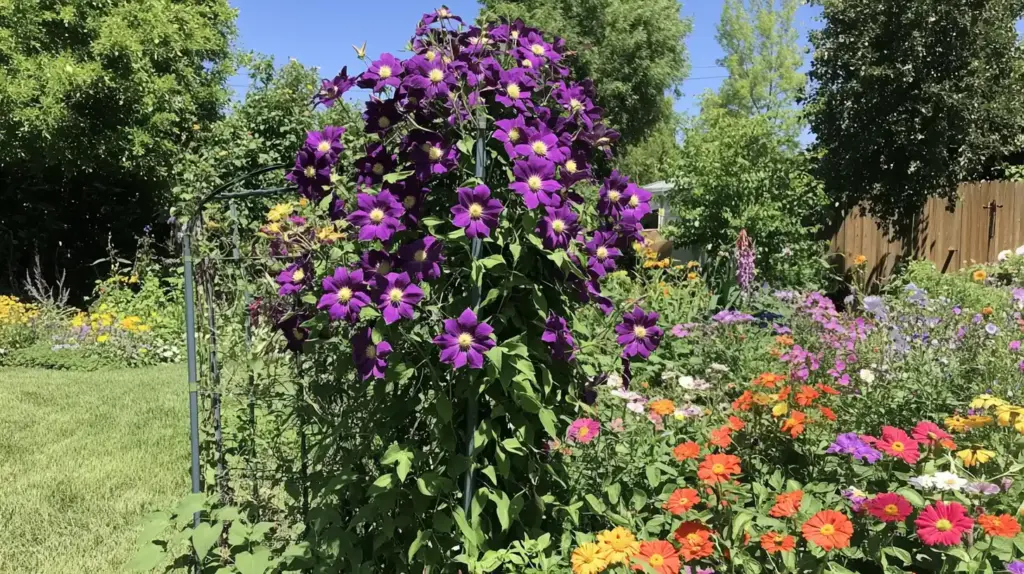
Conclusion
Growing clematis vines is one of the most rewarding ways to introduce vertical beauty, lush foliage, and vivid blooms into your garden. Whether you’re planting them to climb a trellis, cover a fence, or add structure to your landscape, growing clematis vines offers stunning results with relatively little maintenance. With the right planning—from selecting the best variety and garden site to installing a sturdy support—you’ll enjoy an eye-catching floral display that returns year after year. Whether you’re a beginner or seasoned green thumb, growing clematis vines is an elegant, dependable choice. For support inspiration, check out our guide on DIY garden trellis ideas.

